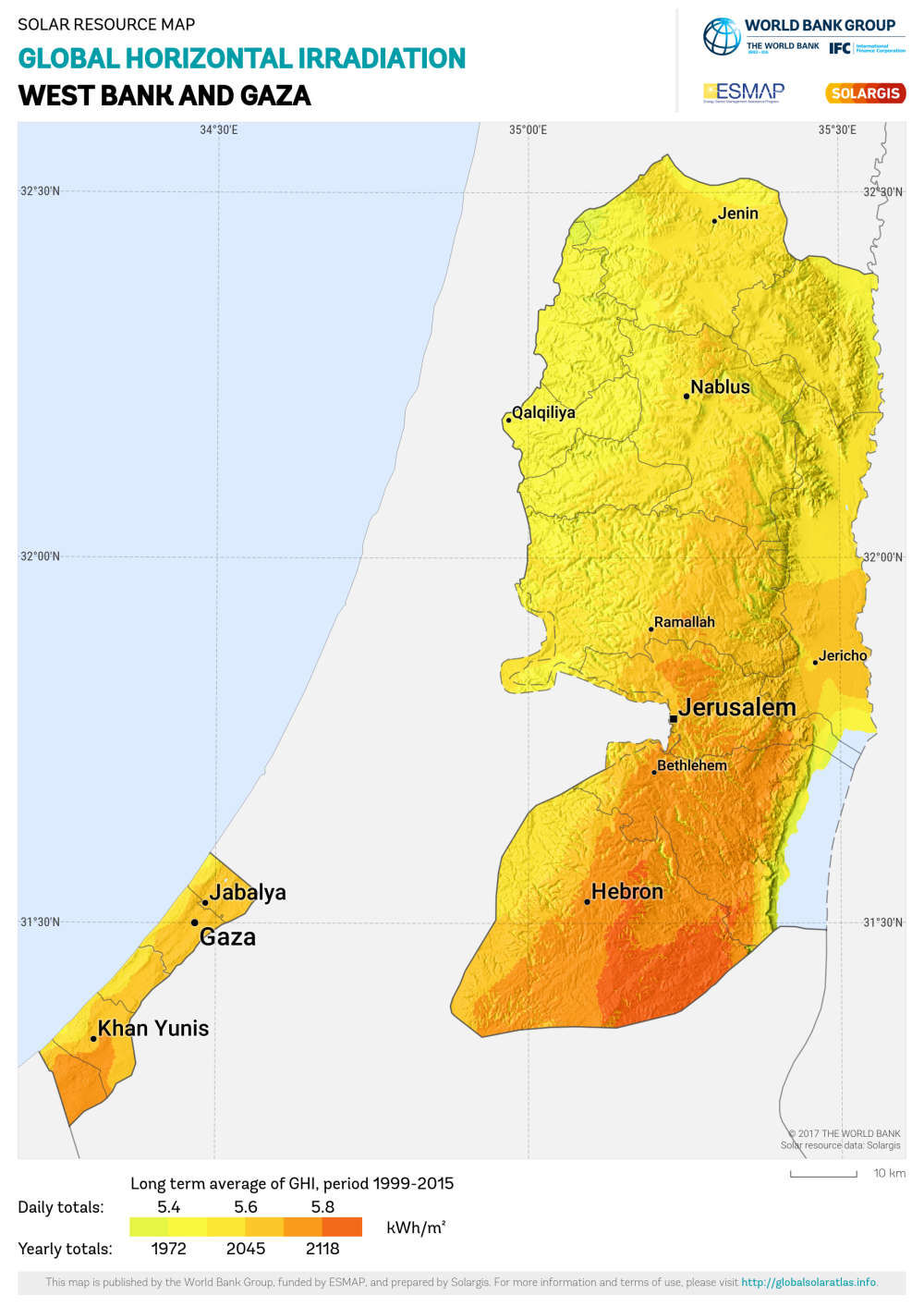
By Elizabeth Brownell and
Gregor von Medeazza
Access to safe drinking water is at a crisis point in Gaza. A single aquifer is the only source of natural water within the Gaza Strip. But as of 2017, only 3.8 percent of water from the aquifer was suitable for domestic use, according to international guidelines.i The water is not only biologically contaminated but also contains higher concentrations of salts and dissolved minerals than are allowed by the guidelines. Therefore, brackish-water desalination (BWD) is critical to providing sufficient drinking water in Gaza.
UNICEF and the Massachusetts Institute of Technology (MIT) have partnered to develop an innovative solar-driven desalination prototype that could potentially revolutionize water production in Gaza. In comparison to conventional methods, this prototype requires less specific energy, it can be operated off-grid with solar energy at lower cost, and it is more efficient in terms of its recovery ratio – a larger proportion of the brackish water extracted from the ground is transformed into freshwater, as compared to the conventional systems currently used in the Gaza Strip.
Currently, over 150 small reverse-osmosis (RO) brackish-water desalination plants are operating in the Strip. However, there are several limitations for these grid-powered RO plants: RO is an energy-intensive process, and Gaza is already in an energy deficit and experiences frequent blackouts. On-grid desalination plants put more pressure on an already-strained electrical grid, and plants cannot operate during blackouts. Moreover, the RO process only recovers roughly 40 percent of the (input) feedwater as drinkable (product) water. The remaining 60 percent is wasted as brine and must be disposed of – adding further strain on a wastewater system that is unable to handle current demands. With water scarcity so pressing, increasing recovery is a critical improvement to desalination processes.
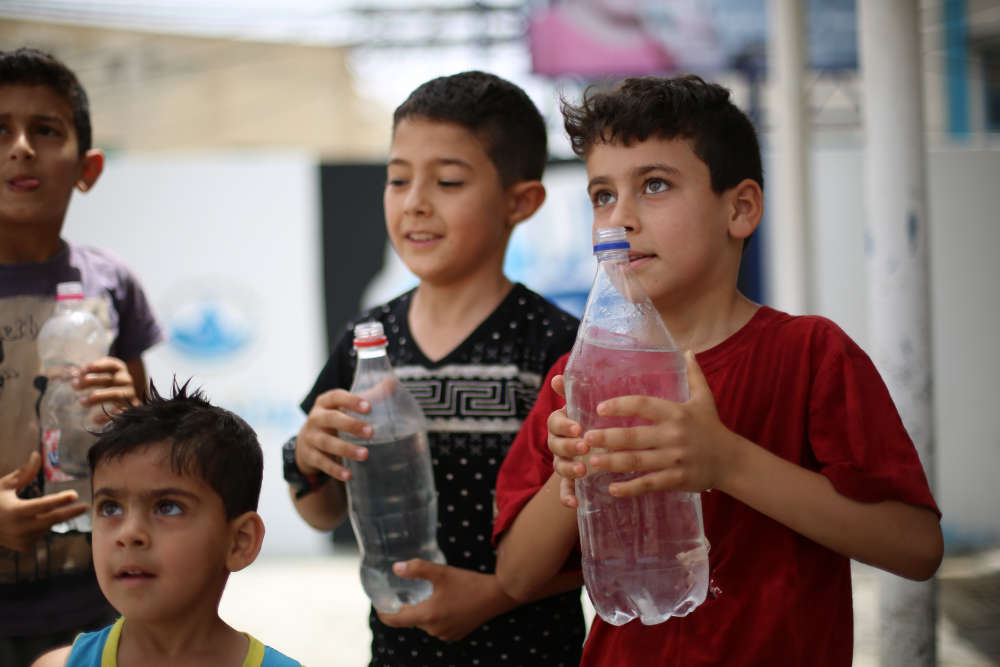
In 2016, UNICEF and MIT partnered to develop a photovoltaic-powered electrodialysis (PV-ED)ii desalination system as an alternative to the conventional on-grid reverse osmosis (OG-RO) for brackish-water desalination,iii with funding from USAID. This prototype was installed in the Gaza Strip in March 2018, and was designed to produce 10,000 liters of potable water per day from an existing brackish well close to Khan Younis refugee camp. The preliminary results are promising. Even though the pilot system is relatively small, it shows that PV-EDR BWD is an effective way to provide affordable, reliable, and safe potable water within the Gaza Strip, making more efficient use of both water and energy resources than conventional OG-RO plants. The underlying principles behind the system’s design can be scaled to larger plants in the future and provide a sustainable water supply.
The main source of drinking water for Gaza’s nearly two million people, the Coastal Aquifer Basin, stretches from northern Egypt up to the coastline of Israel, encompassing the Gaza Strip. Overdrawing from this aquifer has resulted in serious degradation of the water quality. It is predicted that by 2020, the aquifer will be irreparably damaged.iv Due to the poor water-quality conditions, most Gazans buy their water from private water vendors. However, water from these vendors is not only expensive but also largely unregulated and of unreliable quality.v As this situation suggests that desalination is one of the most viable means of providing access to safe drinking water, UNICEF installed a dozen small BWD plants in the Gaza Strip between 2011 and 2013 as an emergency intervention. The capacity has since increased, and presently over 150 BWD plants are operating in the Strip.vi These plants are OG-RO, as is conventional in the area.
The desalination capacity in Gaza is limited, however, by the unreliable nature of grid electricity. With an electricity demand of 450 MW, and a supply of less than 150 MW, daily blackouts are common and can reach 20 hours per day. This deficit is expected to increase in the coming years. Because desalination is an energy-intensive process, the amount of desalinated water that can be produced is limited, even when the infrastructure is available.
Gaza has, however, a high potential for development of solar resources.vii Irradiance levels as high as those recorded in Gaza are encountered in only 35 percent of the world’s land area. This makes solar power an attractive option.
Two main desalination technologies are currently available. In the RO process, a pressure differential is applied that is greater than the osmotic pressure of the feedwater. This pressure forces water through a semi-permeable membrane, leaving behind salts and other contaminants. Because the osmotic pressure increases with salinity, more pressure must be applied during RO with higher-salinity feedwater. This drives operating costs to increase with salinity.
In an electrodialysis (ED) desalination system, the salt particles in the water (as they tend to dissolve into ions) are removed by applying a current through the water.
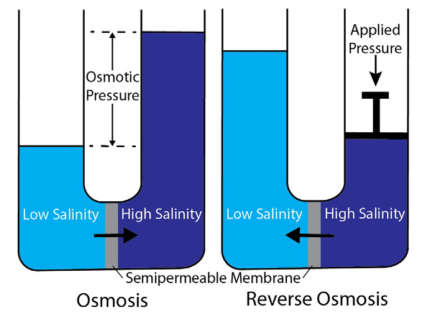
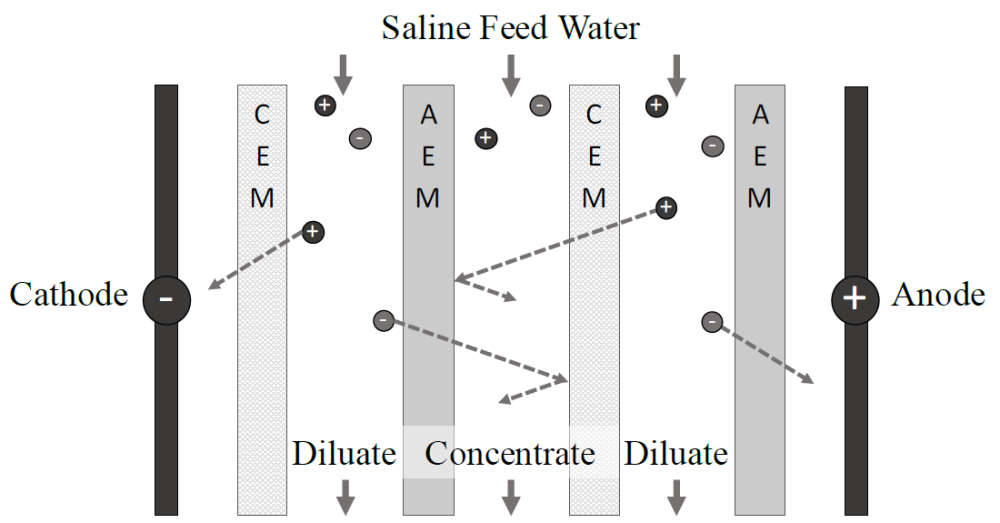
For the pilot project, the Al-Saada well in Khan Younis was selected as the most favorable among a number of potential sites. This well is operated by the Coastal Municipalities Water Utility, which allows for easy access for operators and system monitoring. A technician can operate the system for up to 12 hours per day. In addition, there is sufficient open space for the solar panels and good existing infrastructure. The salinity at Al-Saada well falls within the range of Gazan groundwater.
Our PV-EDR system was designed to produce 10 m3/day of potable water, serving an estimated 3,000 people. The system removes dissolved salts via the EDR process and biological contaminants via pre-filtering and ultraviolet treatment. The planned recovery ratio is 91 percent.
Comparing the energetic and economic aspects of the two technologies, PV-EDR was favored over RO based on energy per unit water produced, cost per unit water produced, functionality, and maintainability.
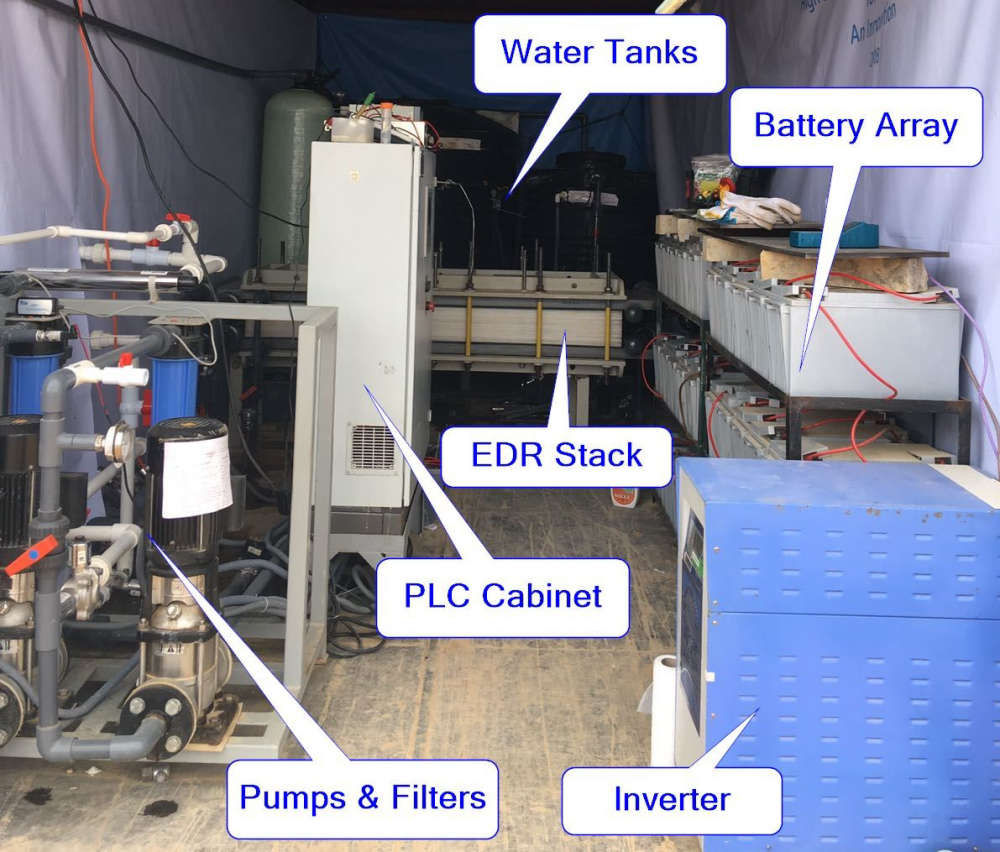
Whereas ED has a lower initial capital cost, operation becomes more expensive as the feedwater salinity increases. However, at salinities less than roughly 5,000 ppm, (which matches the groundwater salinities found in Gaza), ED operation remains more cost-effective than RO, as indicated by the highlighted region on the graph. Also, ED membranes have a longer lifetime (10 years) than RO membranes (3 to 5 years). Whereas ED membranes are more expensive, the lifetime membrane cost is lower due to their higher durability. Therefore, ED was selected as a lower-cost technology for the pilot system.
Another primary driver towards ED in Gaza is its increased recovery ratio, or the percentage of feedwater that can be recovered as drinkable diluate. Operating at 80–90 percent recovery, the ED system makes more use of the available water than existing RO systems. This means that the prototype could produce one-and-a-half times as much desalinated water from a fixed amount of feedwater, compared to the conventional RO plants. In the water-scarce Gaza Strip, this is significant, as it also reduces the volume of wastewater from the brine that needs to be treated and disposed.
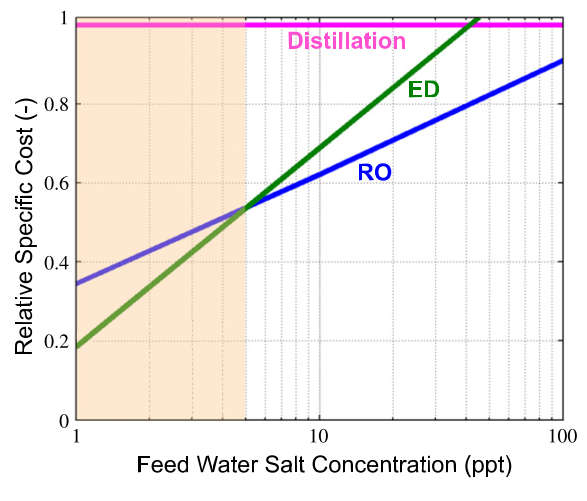
The system is exciting for yet another reason. Because it relies on sun energy, it is not affected by Gaza’s frequent power outages and thus more reliable than conventional on-grid technologies. Moreover, this allows for more economical operation once installed.
And finally, the systems-level-optimization modeling used for its design can be applied to plants of varying scales, depending on the needs of the community. This means that larger and smaller facilities can be designed in more cost-effective ways.
The innovative photovoltaic electrodialysis desalination system is thus a potential game changer for safe water production in the Gaza Strip since it reduces energy use by up to 60 percent; operates only through solar power; transforms around 90 percent of the water it extracts from the aquifer into fresh drinking water; and lowers production costs. These combined benefits make this new technology a promising scalable innovation for other water- and energy-scarce contexts around the world.
i UN, Gaza Ten Years Later, 2017, pg 33, available at https://unsco.unmissions.org/sites/default/files/gaza_10_years_later_-_11_july_2017.pdf.
ii Also abbreviated as EDR, where the letter R stands for reversal; for an explanation of various electrodialysis desalination systems, see GemWater: EDI/EDR at http://www.gemwater.it/?q=en/edi_edr.
iii Devarajan Ramanujan, Natasha Wright, Sebastien Truffaut, Gregor von Medeazza, Amos Winter, “Sustainability Analysis of PV-Powered Electrodialysis Desalination for Safe Drinking Water in the Gaza Strip,” International Desalination Association World Congress, São Paulo, Brazil, available at http://gear.mit.edu/papers/village_desal/IDA17WC-58045_Ramanujan.pdf.
iv UN, Gaza Ten Years Later, 2017.
v United Nations Economic and Social Commission for Western Asia (UN-ESCWA) and German Cooperation, “Coastal Aquifer Basin. Inventory of shared water resources in Western Asia,” United Nations; 2013, available at https://waterinventory.org/groundwater/coastal-aquifer-basin.
vi Gregor von Medeazza, Mohanlal Peiris, Zaidan Abu Zuhry, “Innovative approaches for the construction of Gaza’s largest seawater desalination plant,” Waterlines. 2017, available at https://www.developmentbookshelf.com/doi/full/10.3362/1756-3488.17-00008.
vii Marcel Šúri, Nad’a Šúriová, Juraj Beták, et. al., “Solar resource potential mapping: Country study of the State of Palestine,” GIS Ostrava, 2015, available at http://gisak.vsb.cz/GIS_Ostrava/GIS_Ova_2015/sbornik/papers/gis20155430436417390.pdf.
viii Natasha Catherine Wright, Amos G. Winter, “Justification for community-scale photovoltaic-powered electrodialysis desalination systems for rural India,” MIT, 2014, available at https://dspace.mit.edu/handle/1721.1/92115.
Elizabeth Brownell is the Engineering Program Manager at the MIT Global Engineering and Research (GEAR) Lab. With GEAR Lab, Elizabeth has worked on projects ranging from brackish-water desalination in Gaza, to drip irrigation in Bolivia, to prosthetic feet in India.
Dr. Gregor von Medeazza is the chief of the Water, Sanitation and Hygiene (WASH) program of the United Nations Children’s Fund (UNICEF) for the State of Palestine. Over the past 14 years, Gregor has served in a dozen countries in Africa, South Asia, Latin America, and the Middle East, as well as in Brussels with the European Union, Washington DC, with the Inter-American Development Bank, and in UNICEF’s New York headquarters.

